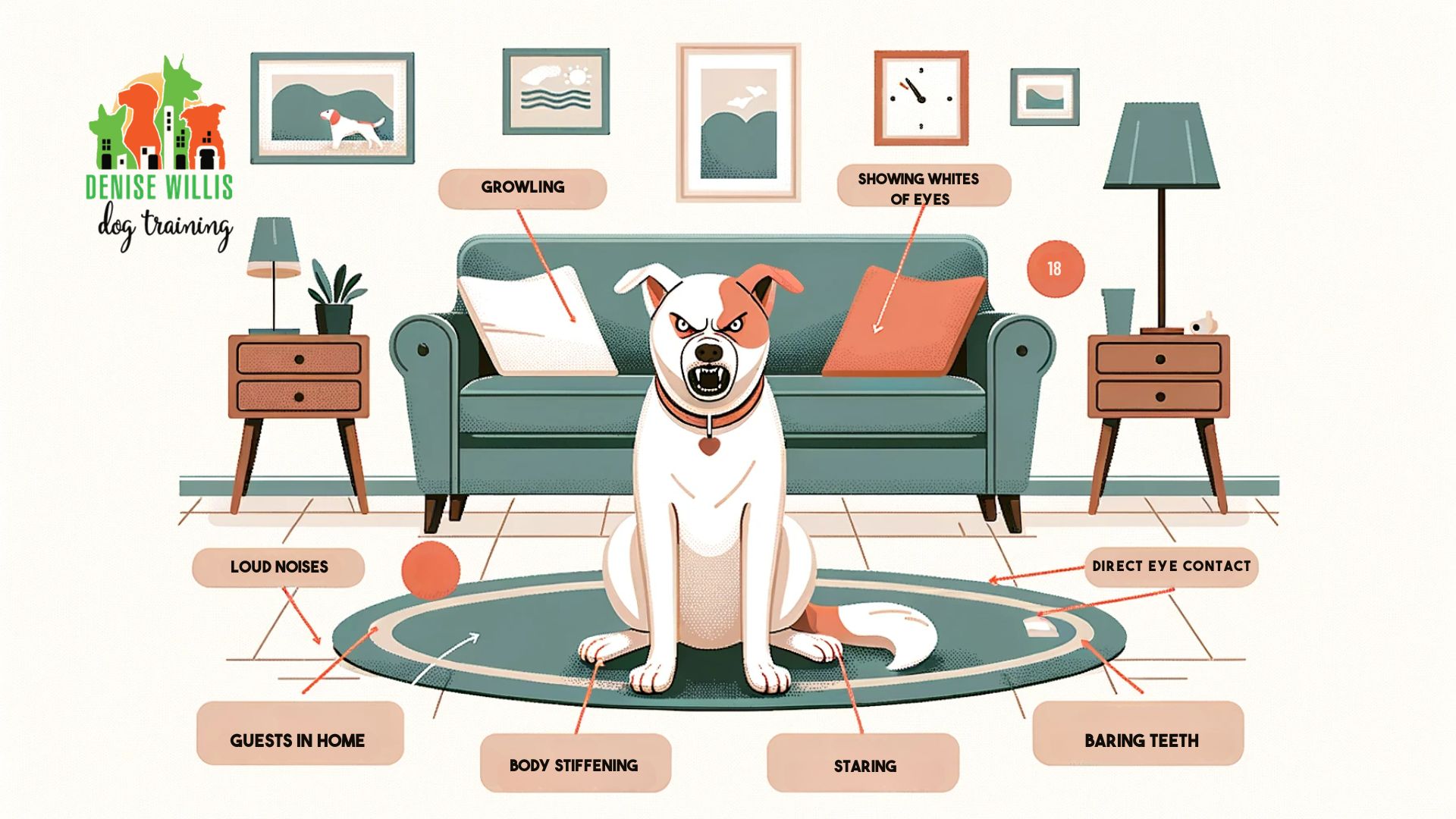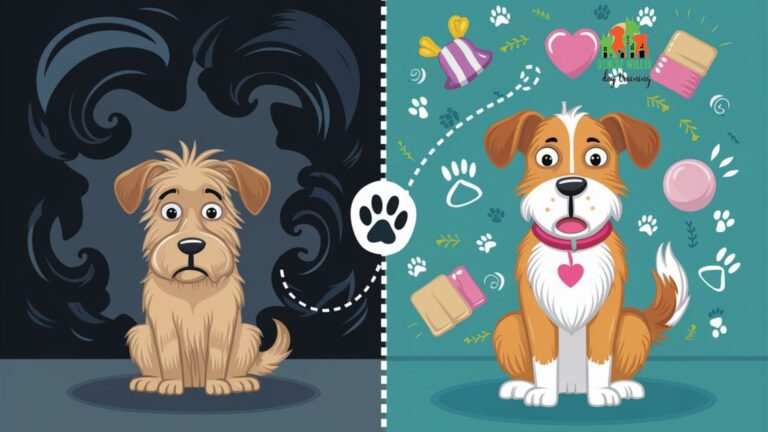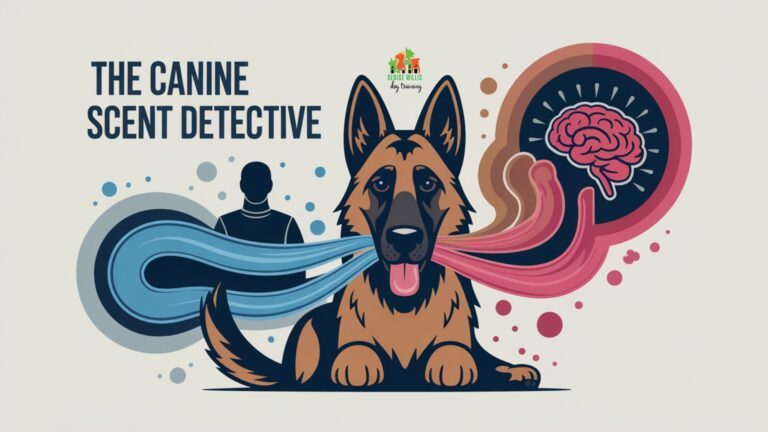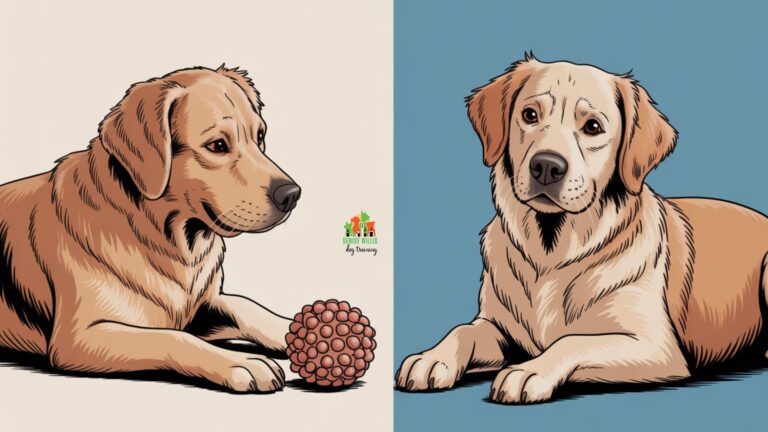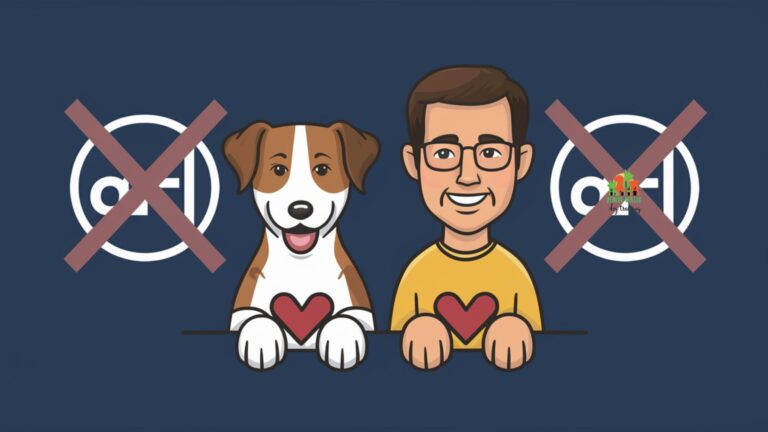Signs of Aggression in Dogs: How to Identify and Respond to Them for a Harmonious Home
📍 Service Area Notice: DW Dog Training provides in-person training services exclusively in the Greater Baltimore area. While our blog content is designed to help dog owners internationally, our hands-on training services are locally focused. For readers outside our service area, we hope you find value in our articles and welcome you to reach out with questions!
Dog aggression refers to a range of behaviors that dogs use to threaten or cause harm to other dogs or people. While often perceived as offensive actions, aggressive behaviors can also be defensive reactions motivated by fear, anxiety, or perceived threats. Recognizing the subtle early warning signs as well as overt acts of aggression is key to understanding your dog’s body language and preventing potential injury.
What is Dog Aggression?
Aggression encompasses various behaviors dogs use to increase distance from a perceived threat or express their intentions through actions. Growling, barking, lunging, biting, and other behaviors are natural forms of communication for dogs, but display a willingness to use force. Aggression exists on a spectrum from subtle signs like lip licking to actual attacks. While dogs rarely bite without warning, pet parents often miss the initial cues.
Overview of Common Signs and Types of Aggression
Dogs use an escalating sequence of behaviors to communicate aggression. Early calming signals like yawning, freezing, and avoiding eye contact indicate discomfort. As arousal increases, dogs may show teeth, snap, bite, or attack. Common aggressive responses include:
- Territorial aggression: Protecting perceived property/space
- Possessive aggression: Guarding resources like food or toys
- Fear/anxiety aggression: Reacting defensively to perceived threats
- Pain-based aggression: Lashing out when hurt or anticipating pain
- Redirected aggression: Redirecting excitement/frustration toward another target
Dog aggression has many sources, targets, and expressions. Recognizing the subtleties in your dog’s body language allows you to identify issues early and address the underlying motivation for aggressive behaviors.
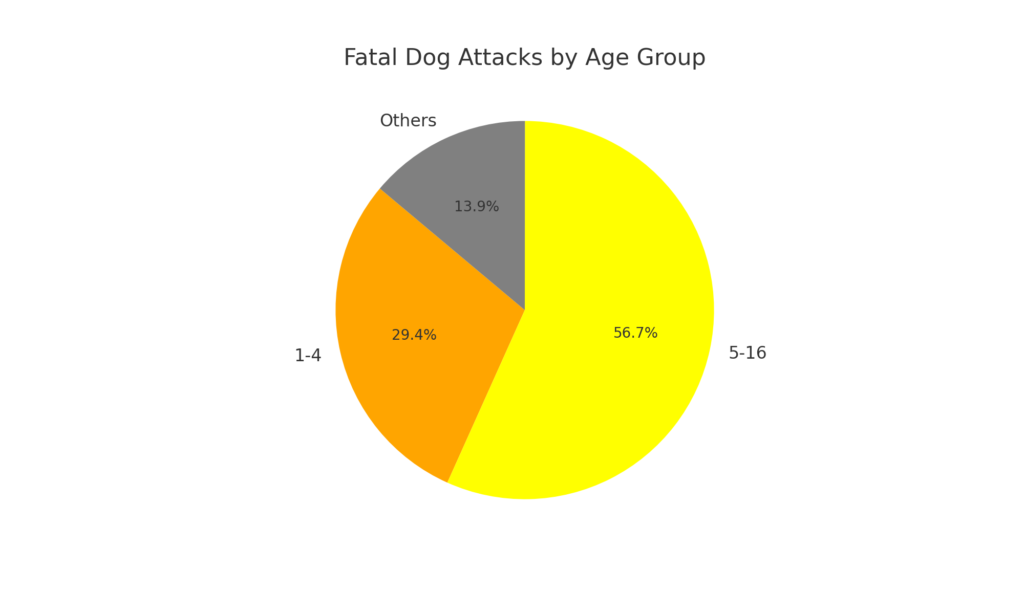
Key Takeaways on Signs of Dog Aggression
- Aggression encompasses a range of behaviors dogs use to threaten or cause harm, often motivated by fear or perceived threats.
- Warning signs include subtle signals like lip licking as well as overt actions like biting. Early recognition is key.
- Common types of aggression include fear-based, territorial, possessive, redirected, and pain-related.
- Aggression is influenced by both genetics and environment/experiences. Proper socialization and training can prevent issues.
- Punishing aggression often increases reactivity. Positive reinforcement training addresses the motivation behind behaviors.
- Consult professionals at the first sign of aggression. They can advise on safety, behavior modification, and medication if needed.
- Prevention via enrichment, training, medical care and reducing stress sets up success. Ongoing management is still required in some cases.
- Living with an aggressive dog takes patience, compassion, and commitment to their ongoing welfare and training.
- If aggression becomes unmanageable, the experts at DW Dog Training can help get your dog and family back on track.
Warning Signs of Aggression
Reading your dog’s body language allows you to recognize escalating aggression before it results in harm. Being attuned to subtle changes as well as overt behaviors helps you respond appropriately.
Subtle Early Signals
Dogs first display calming signals to avoid conflict. Early signs of discomfort include:
- Lip licking or tongue flicking
- Yawning when not tired
- Sudden freezing in place
- Briefly avoiding eye contact
Seeing these behaviors means your dog is feeling anxious or conflicted. Respect these distance-increasing cues before aggression progresses.
Overt Aggressive Behaviors
As dogs become more aroused, aggression intensifies. Overt threatening behaviors include:
- Barking and growling
- Baring teeth
- Stiff or rigid body
- Lunging forward or charging
- Snapping jaws
- Nipping or mouthing skin
These obvious signs mean your dog is highly alert and ready to use force. Intervene immediately to prevent escalation.
Biting behaviors
Once aggression peaks, dogs progress to bites. Biting behaviors include:
- Quick nips without punctures
- Single bite and release
- Repeated bites in rapid succession
- Bite and shake or hold
- Deep puncture wounds
Table 1: Escalating Signals of Aggression
| Early Warning Signs | Threat Displays | Attack Behaviors |
| Lip licking | Barking | Biting |
| Yawning | Growling | Punctures |
| Avoiding eye contact | Lunging | Multiple bites |
| Freezing | Baring teeth | Bite and shake |
Punctures and wounds require immediate medical care. Bites without injury still need addressing to prevent future harm.
Watch for subtle body language shifts in addition to teeth baring and vocalizations. Early recognition allows you to mitigate aggressive responses before behavior crosses into biting.
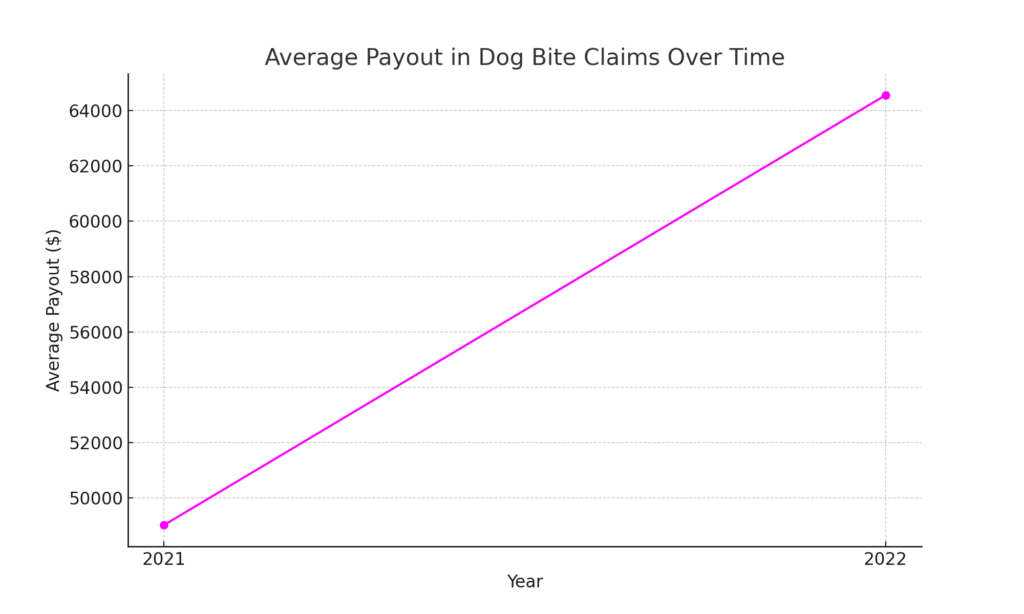
Common Types of Dog Aggression
While aggression takes many forms, certain categories reflect common motivations behind dogs’ threatening behaviors. Knowing what triggers your dog helps address the root cause.
Territorial Aggression
Territorial aggression involves protecting perceived property, which often includes a dog’s home and yard. Dogs may display territorial behavior towards guests, passersby, or other animals encroaching on their domain. Territorial aggression signs include:
- Barking and charging at fences or windows
- Blocking entrances/exits
- Staring, growling, or snapping at visitors
Establishing secure perimeters and structured greetings can reduce territorial behavior.
Table 2: Common Aggression Triggers
| Environment | Health | Social |
| Construction noises | Pain/discomfort | Unfamiliar people |
| Guests in home | Illness/medication | New baby in home |
| Changes in routine | Cognitive issues | Proximity to other dogs |
| Loud noises | Nutritional factors | Being restrained |
Possessive Aggression
Also called resource guarding, possessive aggression happens when dogs feel threatened that valued items will be taken away. These resources might include:
- Food or treats
- Bones, toys, or other objects
- Sleeping areas
Dogs may growl, bare teeth, or bite when approaching items they are guarding. Trading items for high-value treats and respecting space, when dogs have resources, can help.
Fear/Anxiety Aggression
Fear and anxiety are common motivators for aggressive behaviors. Dogs may react defensively when frightened by perceived threats like:
- Unfamiliar people
- Being cornered/trapped
- Loud noises
- Anticipating something unpleasant
Desensitization training, calming products, and building confidence can help minimize fearful reactivity.
Identifying the context and target of your dog’s aggression provides insight into appropriate treatment approaches to try.
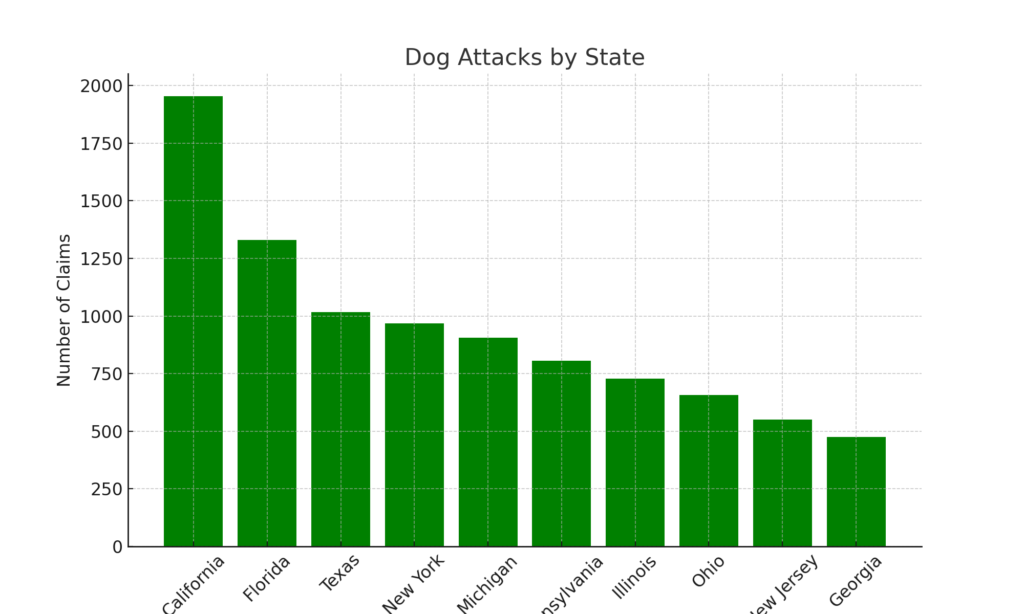
Causes and Triggers of Aggressive Behavior
There are a variety of potential causes of dog aggression. While breeds may have general tendencies, nature and nurture both play key roles in shaping behavior.
Genetics and Early Development
Genetics contribute to personality traits that may increase aggression, including fearfulness or dominance. However, genetics do not necessarily doom dogs to aggressive destinies. Early positive socialization experiences are critical for teaching bite inhibition and appropriate interactions.
Trauma and Negative Experiences
Past trauma and negative associations can lead to aggressive responses later in life. For example, dogs subjected to abuse may react defensively to being handled a certain way. Careful counterconditioning can help overcome bad experiences.
Medical Conditions and Pain
Pain or illness often increases irritability and lowers the threshold for aggression. Dogs may react when anticipating or experiencing discomfort. Thyroid dysfunction, neurological issues, arthritis, and dental disease can all elicit aggressive reactions. Veterinary exams help rule out medical causes.
Environmental Triggers and Stressors
Situational factors frequently precipitate aggressive displays. Changes to routine, noisy construction, unfamiliar guests, or proximity to other animals can all trigger territorial behavior. Reducing environmental stressors and providing stability helps minimize reactivity.
While genetics play a part, proper socialization, training, medical care, and a stable environment significantly shape and mitigate aggression tendencies.
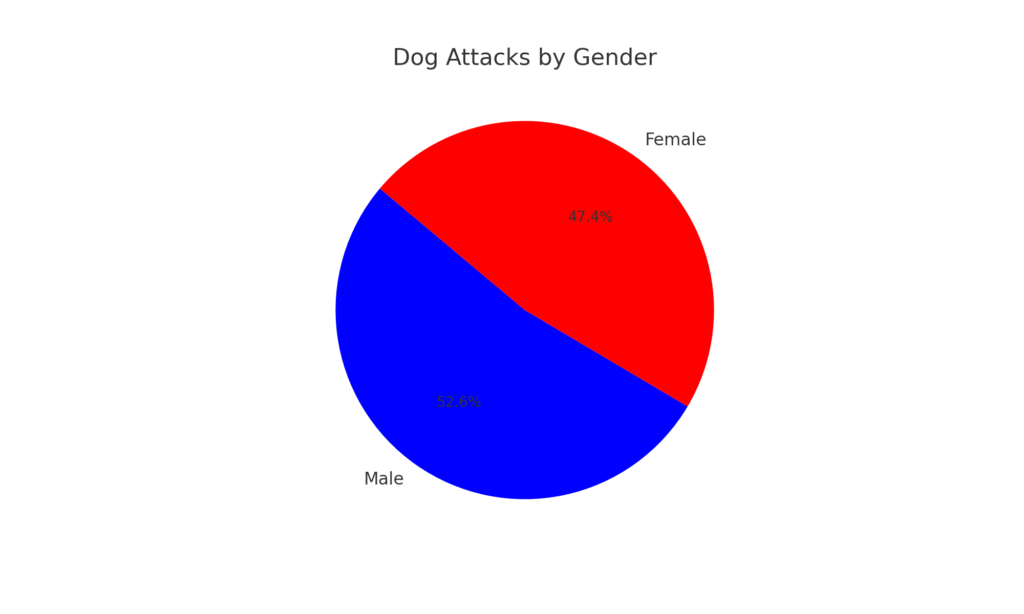
Breed Mythology and Dog Aggression
Despite breed-related stereotypes, no dog is inherently aggressive based solely on its genetic lineage. Both nature and nurture shape canine behavior.
No Breed is Inherently Aggressive
Certain breeds like guard dogs or terriers have reputations for aggression due to their histories. However, a dog’s breed itself does not doom it to react aggressively. With proper socialization and training, even breeds developed for defense or pest control can become trustworthy companions.
Size and Strength Influence Perceived Aggression
A dog’s size and physical abilities contribute greatly to how its behavior is perceived. Small dogs may exhibit objectively “aggressive” behaviors like barking, lunging, or even nipping with relative impunity. The same conduct from large, powerful dogs evokes more fear. But size does not equal aggression. All dogs should receive training to curb problematic reactive and biting behaviors.
Nature Vs. Nurture in Dog Behavior
Dog behavior reflects an interaction between genetic predisposition and life experiences. While breeds may differ in activity levels, trainability, or inherent wariness, how dogs are raised, trained, and socialized play a greater role in determining the presence of aggression than lineage alone. Providing evidence-based care tailored to the individual promotes friendly companions regardless of breed tendencies.
Blaming aggression solely on breed ignores the proven impact of socialization, training, health, and environment in shaping dog behavior, whether positive or problematic.
Responding to Dog Aggression
When facing aggression, safety should be the top priority. Punitive methods often exacerbate reactivity. Addressing the motivation behind the behavior and using positive reinforcement training are the most effective.
Recognizing Stress Signals
Pay close attention to your dog’s subtle body language indicating anxiety or conflict. Yawning, lip licking, avoiding eye contact, and frozen posture are early cues to respect your dog’s comfort zone before aggression escalates.
Avoiding Punishment
Punishing warning signals like growling for resources teaches dogs to skip cues and bite without warning. Positive reinforcement methods preserve communication while reducing undesirable behavior.
Identifying and Addressing Triggers
Carefully analyze the antecedents, targets, and patterns behind your dog’s aggressive responses. What environmental, inter-dog or handler-related factors consistently precede reactions? Modifying triggers and teaching alternative behaviors can prevent aggression in triggering contexts.
Positive Reinforcement Training
Use reward-based training to condition your dog to associate unpleasant stimuli with positives. For example, reward calm behavior in the presence of guests. Consult a certified professional for customized behavior modification protocols.
While aggression cannot always be “cured,” implementing science-based approaches greatly improves dog behavior and promotes human safety.
Preventing Aggressive Behavior
While some dogs are genetically prone to reactivity, proper socialization, training, and care from an early age can help prevent aggressive tendencies.
Proper Socialization and Training
Introducing puppies to a wide range of people, animals, places, sights, and sounds helps avoid fear-based responses later in life. Early positive training establishes communication and trust while curbing undesirable behaviors like nipping.
Providing Enrichment
Dogs with insufficient physical and mental stimulation are more likely to develop problematic behaviors like aggression. Ensuring your dog receives adequate exercise, play, food puzzles, and training prevents boredom and frustration.
Maintaining Health and Welfare
Undiagnosed pain or illness can contribute to irritability. Veterinary care, proper nutrition, grooming, and other basic needs being met are crucial for your dog’s behavior and temperament. Spay/neuter surgery may also reduce hormonal influences on certain types of aggression.
Building Trust and Communication
Nurturing a strong bond and free flow of communication with your dog from the start provides a solid foundation. Respecting cues and using positive reinforcement training fosters mutual trust and understanding.
Promoting wellness, providing enrichment, socializing properly, and establishing open communication through early training help set puppies up for friendly, confident temperaments.
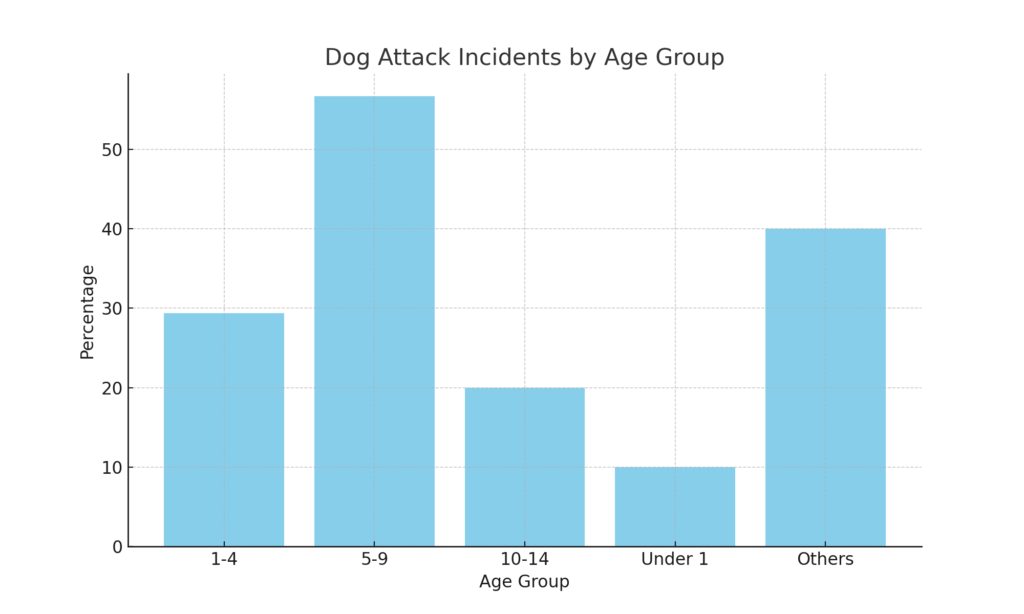
Creating a Safe Home Environment
If your dog exhibits concerning aggressive behaviors, adjustments to their routine, environment, and your handling can help minimize reactivity at home.
Management and Supervision
Prevent rehearsal of problem behaviors by separating your dog from triggers like guests, dogs, or kids using crates, gates, or leashed supervision. Restrict access to potential guarding items. Don’t leave dogs unsupervised together.
Routine, Exercise, and Reducing Stress
Try to maintain consistent schedules for meals, walks, training, play, and rest. Ensure your dog receives adequate physical and mental exercise. Use enrichment toys and calming supplements to reduce stress.
Modifying the Environment
Evaluate your home for potential territorial triggers like proximity to windows/doors and visibility of passersby. Block sightlines, insulate against noises, and create a secure den area. Pheromone diffusers may also help relax the environment.
Ongoing Training and Behavior Modification
Continue working with a certified professional using positive reinforcement-based protocols customized for your dog. Consistency, patience, and incremental progress are key, even if behavior change is slow. Lifelong management may be required in some cases.
While not a cure, conscientious care and handling precautions can help minimize aggressive responses and the inherent risks. The goal is to improve your dog’s quality of life as much as possible.
When to Seek Help for an Aggressive Dog
While all aggression needs addressing, seeking outside assistance is especially crucial in higher-risk situations or if problems persist despite your efforts.
Working with Dog Trainers and Behaviorists
Trainers certified in aggression can advise on safety, management, desensitization, and medication. Behaviorists formulate behavior modification plans and ensure correct implementation. Their guidance reduces injury risks and improves training efficacy.
Consulting Your Veterinarian
Schedule a veterinary exam first to identify any medical factors contributing to aggressive responses. Your vet can refer you to a specialist if needed. They can also prescribe medication in applicable cases.
Table 3: Professional Help Options
| Trainer | Behaviorist | Veterinarian |
| Safety consulting | Customized treatment plans | Medical exam |
| Management tips | Ongoing support | Pain identification |
| Positive reinforcement protocols | Qualified for medication | Specialist referral |
| Consistency coaching | Rehoming recommendation | Prescribe medication |
Medication May be Required
In some instances, medication can help take the edge off a dog’s anxiety or frustration tolerance while behavior training is ongoing. Veterinary supervision ensures appropriate drug choices and dosing.
Rehoming in Severe Cases
If the quality of life is irrevocably poor or the risks are too high despite extensive management and training efforts, rehoming or euthanasia may need to be considered with veterinary and trainer guidance.
Seeking professional assistance from the start provides the greatest opportunity for successfully overcoming aggression issues and preserving the human-animal bond.
Living Happily with an Aggressive Dog
While challenging, it is possible to have a good quality of life with an aggressive dog. Success requires patience, compassion, advocacy, and a commitment to ongoing management.
Patience, Management, and Compassion
Curbing aggression takes immense patience and daily diligence. Work with professionals to implement customized management protocols that keep all family members safe while also meeting your dog’s needs. Never lose compassion for your dog despite their problematic behaviors.
Advocating for Your Dog’s Needs
Fight breed stereotypes and make others aware of your dog’s sensitivities. Politely ask strangers not to approach or pet your dog. Advise guests on appropriate interactions. Be your dog’s voice promoting their welfare.
Continued Training and Support
Consistent, lifelong positive reinforcement training maximizes progress over time. But remain realistic – aggression may never fully resolve. Join online groups to exchange tips with others managing similar issues.
Giving them a good quality of life
Enrich your dog’s daily routine with puzzles, nosework, training games, and special treats. Ensure their basic needs are met. Celebrate small successes. Find activities you can both enjoy together. Despite the challenges, focus on the joy.
While requiring significant effort, emphasizing compassion, safety precautions, training, and enrichment enables peaceful coexistence in many cases.
Get Help from DW Dog Training for Aggressive Dogs
Living with an aggressive dog can be extremely difficult, but help is available. If your beloved canine companion is exhibiting any concerning behaviors like those outlined in this article, don’t delay – contact the experts at DW Dog Training right away.
Our skilled professional trainers have extensive experience successfully working with aggressive dogs of all breeds and backgrounds. We understand the nuances of canine communication and the various factors that can motivate aggression.
At DW Dog Training, we employ positive reinforcement techniques to address the root causes of aggressive behaviors and teach alternative reactions. We can provide customized behavior modification protocols tailored to your unique situation and needs. Our consultative approach also empowers you with the knowledge to better advocate for your dog.
From initial private consultations to tailored training programs, we have solutions. If your dog’s aggression is becoming unmanageable or putting your family at risk, we encourage you to reach out. DW Dog Training can help you get back to enjoying a happy, harmonious relationship with your beloved dog.
Don’t wait – aggressive behavior seldom resolves on its own. Contact DW Dog Training today to schedule your initial consultation. Our dedicated aggression experts look forward to helping you and your dog live better together.

